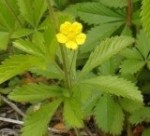 Common cinquefoil, also known as oldfield cinquefoil, is a low growing perennial that resembles a strawberry plant with yellow flowers. It is native to tall grass prairies but is now found all through eastern and central North America. It thrives in sun to partial shade in a variety of soils and is common in dry woods, roadsides, abandon fields, lawns and perennial beds that are infrequently cultivated. Common cinquefoil is more of an annoyance that an invasive weed. It is not aggressive and the flowers are bright and cheerful, although not very numerous at any given time.
Common cinquefoil, also known as oldfield cinquefoil, is a low growing perennial that resembles a strawberry plant with yellow flowers. It is native to tall grass prairies but is now found all through eastern and central North America. It thrives in sun to partial shade in a variety of soils and is common in dry woods, roadsides, abandon fields, lawns and perennial beds that are infrequently cultivated. Common cinquefoil is more of an annoyance that an invasive weed. It is not aggressive and the flowers are bright and cheerful, although not very numerous at any given time.
 Description: Shoots of common cinquefoil appear in spring when the soil is warm. At first the stems
Description: Shoots of common cinquefoil appear in spring when the soil is warm. At first the stems  grow erect and can reach 12” but they soon sprawl along the ground and send out stolons up to 3’ long that may root at the tips when they come in contact with the soil . The slender stolons are green at first but turn red as they mature. The alternate leaves are plamately compound with five leaflets. Each leaflet is about 3” by 1”, and is coarsely toothed except at the base. Five-petaled yellow flowers are borne singly on long slender stems from the axils of the upper leaves in spring to mid-summer. The tips of the sepals are shorter than the petals. The fruit is a small single seeded achene. The root is short, thick and fibrous. Common cinquefoil can be distinguished from similar plants by the five leaflets and the sepals that are shorter than the petals.
grow erect and can reach 12” but they soon sprawl along the ground and send out stolons up to 3’ long that may root at the tips when they come in contact with the soil . The slender stolons are green at first but turn red as they mature. The alternate leaves are plamately compound with five leaflets. Each leaflet is about 3” by 1”, and is coarsely toothed except at the base. Five-petaled yellow flowers are borne singly on long slender stems from the axils of the upper leaves in spring to mid-summer. The tips of the sepals are shorter than the petals. The fruit is a small single seeded achene. The root is short, thick and fibrous. Common cinquefoil can be distinguished from similar plants by the five leaflets and the sepals that are shorter than the petals.

 Control: Common cinquefoil is very easy to pull up by hand especially when the soil is moist. Since the weed is not aggressive a small colony can usually be tolerated as the flowers are attractive. The post emergent herbicides such as 2,4-D, dicamba, MCPP, and MCPA are effective but are seldom necessary.
Control: Common cinquefoil is very easy to pull up by hand especially when the soil is moist. Since the weed is not aggressive a small colony can usually be tolerated as the flowers are attractive. The post emergent herbicides such as 2,4-D, dicamba, MCPP, and MCPA are effective but are seldom necessary.